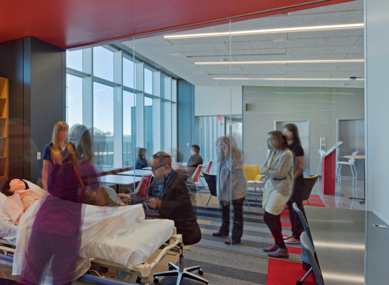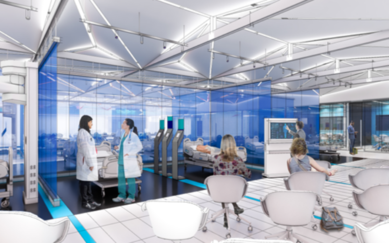Designed for Disruption: The Next Era of Simulation Learning Environments

Today, our higher education system is being challenged by multiple disruptors and an unprecedented rate of change. Rethinking campuses to adapt to the current COVID-19 pandemic, lower enrollment, student life uncertainties and equitable access present complex challenges to the status quo. As higher education strategists with a focus on health profession education, we are convinced simulation learning environments can become a leading model to address the accelerating speed of transformation and disruption throughout higher education.
High fidelity simulation is widely used to provide “true to life” patient care scenarios for the health professions. This face-to-face, hands-on pedagogy prepares students with core clinical competencies, replicating team training experiences with the goal of patient safety once students do become practitioners. This platform for interprofessional education continues to respond to the disruptions the healthcare industry is experiencing.
Recently, the simulation community rallied to continue simulation experiences virtually during this time of viral pandemic. While these efforts during the crisis have been noble and allowed online instruction to continue, they were missing a key component: physical interaction. Physical interactions using high fidelity manikins and standardized patient protocols are critical to the mission of quality care. We are curious how these key interactions might be accommodated safely as students and faculty return to campus.
Most existing simulation environments are not designed to handle the disruptions we are currently encountering. Many have fixed square footages, static walls, immobile equipment and permanent infrastructure. In partnership with institutions across the country, our Higher Education practice is leading the design of next generation learning environments for simulation to flex with changing needs and withstand disruption.
Following are a few approaches for adapting and designing resilient-ready simulation spaces:
Achieve Social Distancing
Many simulation labs are undersized, and unable to support larger interprofessional teams, let alone accommodate current requirements for social distancing. One tactic is to distribute the student team at a safe distance around the simulated patient. At a minimum, two learners can be accommodated around a standard patient bed which measures over six feet. With one student at the head of the bed and a second at the foot of the bed, two students can meet social distancing protocols. The team can then be expanded in various ways:
- Observation rooms can be transformed to enable personal interaction and real time feedback. Consider replacing one-way glass with vision glass in adjacent control rooms and observation rooms. This can allow additional team members to observe the patient through the window and be part of the interprofessional student team.
- Technology advances may allow for additional interprofessional students to be present through a self-driving, two-wheeled videoconferencing robot. This virtual approach would enable students to feel more connected to their teams by giving them a physical presence when they cannot be there in person due to social distancing or schedule conflicts.
- Mount a monitor in the room for additional team members to have a telepresence in the room with their colleagues.
Staggered Scheduling
In addition to physical changes, consider having small student teams (or individuals) use current rooms and stagger their arrival and departures to enable social distancing and to allow time for proper cleaning between students. Simulation suites already mimic sterile environments…why not make this a reality? Also, having more flexible scheduling options for the simulation facilities may provide better equity by offering additional options for learners balancing family or job responsibilities.
Spectrum of Density
Today’s challenge is social distancing, but other disruptors may affect space more directly. Future disruptions may require flexibility to increase and decrease space as the situation requires. One solution is to introduce large doors or a movable wall that opens to the adjacent simulation lab or classroom. This would allow options to enlarge square footage for social distancing, larger interprofessional teams or accommodate a downsize in enrollment. Thinking beyond just the simulation lab, it would be beneficial to incorporate flexibility into the entire simulation suite for extending protocols. This type of agility would also allow options for:
- Partnering with simulation equipment manufacturers for demonstration of new cutting-edge technology
- Continuing education seminars and conferences
- Change in class size based on faculty availability or expertise
White Box Design
While much is uncertain, we know that the constant evolution of technology will require nimble changes for simulation spaces and equipment. Imagine a room that is so universal that it allows for changes in technology, changes in simulation delivery—such as a larger interprofessional team, or any paradigm you desire. This is possible with an open room with a ceiling grid for hanging simulation equipment, power at any location you may need for various set-ups and movable panels that can be pushed and pulled to create spaces all contained within a flexible white box. Think of the benefits of being able to convert a room with dedicated task trainers into immersive high-fidelity spaces without investing in and closing for full scale construction. A white box is resilient-ready simulation for the long-term.
Fiscal Responsibility
If financing is limited for capital investments, colleges and universities could consider taking a ‘room-by-room’ approach, such as transforming one existing room into a prototype white box. Another idea may be to retrofit two or three existing rooms by removing the common walls between them to achieve a spectrum of density. Both approaches offer flexibility and resiliency with a low-cost-of-entry, which is vital as institutions are faced with new disruptors and technology advances.
The COVID-19 pandemic is a reminder that disruptors will continue to impact higher education and simulation learning. By focusing on developing spaces that are resilient and foster high-fidelity experiences, we are confident that interprofessional simulation will continue to advance student learning and ultimately improve patient care and safety.

